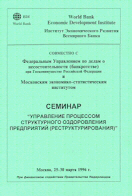and Equity Investing Techniques

SMP Library
|
Western Turnaround Management and Equity Investing Techniques |

SMP Library |
Strategic Management Partners
![]()
![]()
A nationally recognized turnaround management firm
specializing in interim executive leadership, asset recovery,
investing in underperforming distressed troubled companies.
Article SMP Library SMP Home Contact
 |
|
Strategic Management Partners has been key in developing a training course presentation to introduce proven concepts and train turnaround and privatization professionals, government bankruptcy and privatization officials in the Russian Federation, Central Europe, China, and North America. The three day course stresses western turnaround techniques, application of turnaround management in the region(s), converting defense related businesses to peacetime economic enterprises, privatization management, signs of companies heading for trouble, cash flow enhancement, soliciting strategic alliance partners, raising investment capital, equity & venture capital investing techniques, developing exit strategies and negotiating the sale of company transactions.
John M. Collard, Chairman, Strategic Management Partners, Past Chairman of the Turnaround Management Association, a Certified Turnaround Professional (CTP), and Instructor said, "the course is unique in that it brings successful techniques of turnaround management, corporate renewal and equity investing to parts of the world that are undergoing transition. Often, problems in other parts of the world are much different than we normally think of in the U.S. when we undertake to turnaround a troubled enterprise. Two dimensions are added that must be addressed. First, where does the turnaround manager come from? In the western world we teach professionals how to be managers and how to market and sell. They gain experience in healthy companies before they become turnaround managers. In Russia and Central Europe, the ultimate demand economy for the last fifty years, managers have not had to use, nor have they been taught either skill [Marketing nor Management]." So where these managers will come from becomes a real dilemma. Teaching them now has become one answer, but the process will take time.
"The second added dimension is the concept of valuation, which affects both the initial purchase or investment and resalability of the company. Value is assigned to fixed assets by using 'liquidation' or 'net asset' valuation concepts. In a demand economy with inflationary accounting [which writes up assets, sometimes to increase collateral for additional funding], values on the books are usually overstated. Most business people are well schooled in DCF and other methods of applying value. What most miss completely, however is the concept of 'operating assets value', [the ability of the company to produce profits and cash flow]. There is little application of the concept of producing value for what investors or buyers are willing to pay," Collard said. While this will change as time passes, stock exchanges mature, and transactions become more prevalent in the region, until then negotiations will be difficult.
The course was originally designed as a three day presentation, but can be given in one or two day versions; or separated into components if required. It has been well received by sophisticated audiences who want to change the way things are done in their country or for their clients. While parts of the course are specific to the needs of change from a demand economy to free market, the concepts adapt well to the North American audience as well. After all, when a company is in trouble it needs Management, Marketing and Capital, all discussed at length in the course. A Restructuring Specialist, Economic Development Institute at The World Bank, said "this course is exactly what is needed in the Russian Federation and other developing countries that want change management to take them into the Global Economy. It brings a detailed understanding of turnaround management and equity investing techniques to managers that have not had to deal with these issues before. The instructor's years of experience added a depth to this course, with real examples, that was key to help this sophisticated audience grasp these difficult and complex ideas." For more detail of the course presentation in Russia, see
SMP Develops Course for World Bank --- Subsequently, Yeltsin has named Anti-Crisis Management as a profession in Russia, and this course is being taught throughout the country.
Reprinted with permission. The World Bank, 1996. Copyright 1996, Strategic Management Partners, Inc. 410-263-9100
We welcome constructive inquires. More information is available if required.
There is more to Strategic Management Partner's
Return to Home Page
![]()
John M. Collard, Chairman
Strategic Management Partners, Inc.
522 Horn Point Drive
Annapolis, Maryland [MD] 21403
Voice 410-263-9100 Facsimile 410-263-6094 E-Mail Strategist@aol.com
We serve as experts for comment or quote, please contact us at 410-263-9100
![]()
We welcome constructive inquires, please send via E-Mail to:
Strategist.
![]()
|
|
Top
Index
Sections
Contact
PDF Version
|
Copyright © 1996-2005
Strategic Management Partners, Inc.
![]()